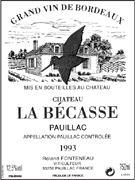
Classification: None
Owner: Georges and Roland Fonteneau
Address: Bages, 33250 Pauillac
Mailing Address: 21, rue Édouard de Pontet, 33250 Pauillac
Telephone: 05 56 59 07 14; Telefax: 05 56 59 18 44
Visits: By appointment only
Contact: Roland Fonteneau
VINEYARDS
Surface area: 9.9 acres
Grape varietals: 55% Cabernet Sauvignon, 36% Merlot, 9% Cabernet Franc
Average age of vines: 35 years
Density of plantation: 8,000 vines per hectare
Average yields: 57 hectoliters per hectare
Elevage: Three-week fermentation and maceration. Eighteen months aging in barrels with 40–60% new oak. Fining, no filtration.
WINES PRODUCED
Château La Bécasse: 30,000 bottles
No second wine is produced.
Plateau of maturity: Within 5–15 years of the vintage
GENERAL APPRECIATION
Worth a Cru Bourgeois.
I owe a great deal of thanks to the late Bernard Ginestet, who first told me about this Pauillac that has previously been known only to a fiercely loyal group of insiders who buy the production. In the handful of vintages I have tasted, the wine possessed good concentration and aging potential.
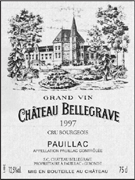
Classification: Cru Bourgeois Supérieur
Owner: SCI Château Bellegrave
Address: 22, route des Châteaux, Saint-Lambert, 33250 Pauillac
Telephone: 05 56 59 06 47; Telefax: 05 56 59 06 47
Website: www.château.bellegrave.fr
Visits: By appointment Monday to Friday, 8 A.M.–noon and 2–6 P.M.
Contact: Ludovic Meffre (ludovicmeffre@yahoo.fr)
VINEYARDS
Surface area: 17.3 acres
Grape varietals: 62% Cabernet Sauvignon, 31% Merlot, 7% Cabernet Franc
Average age of vines: 20 years
Density of plantation: 8,333 vines per hectare
Average yields: 56 hectoliters per hectare
Elevage: Cold maceration. Three-week fermentation and maceration in temperature-controlled stainless-steel tanks. Twelve months aging in barrels with 50% new oak. Fining and filtration.
WINES PRODUCED
Château Bellegrave: 30,000 bottles
Les Sieurs de Bellegrave: 15,000 bottles
Plateau of maturity: Within 3–10 years of the vintage
GENERAL APPRECIATION
Worth a Cru Bourgeois.
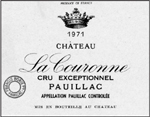
Classification: Cru Bourgeois Exceptionnel
Owner: Françoise des Brest-Borie
Address: 33250 Pauillac
Mailing Address: c/o J. E. Borie SA, 33250 Pauillac
Telephone: 05 56 76 13 73; Telefax: 05 56 59 27 37
No visits
VINEYARDS
Surface area: 9.9 acres
Grape varietals: 70% Cabernet Sauvignon, 30% Merlot
Average age of vines: 25 years
Density of plantation: 10,000 vines per hectare
Average yields: 46 hectoliters per hectare
Elevage: Fifteen to eighteen day fermentation and maceration in stainless-steel vats. Twelve to fourteen months aging in barrels with 20% new oak. Fining, light filtration upon bottling.
WINES PRODUCED
Château La Couronne: 20,000 bottles
No second wine is produced.
Plateau of maturity: Within 5–10 years of the vintage.
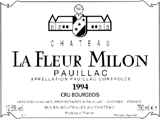
Classification: Cru Bourgeois
Owner: Gimenez family
Address: 14, rue de l’horte, Le Pouyalet, 33250 Pauillac
Telephone: 05 56 59 29 01; Telefax: 05 56 59 23 22
E-mail: contact@lafleurmilon.com
Website: www.lafleurmilon.com
Visits: Monday to Friday, 8:30 A.M.–noon and 2–5 P.M.
Contact: Claude Mirande
VINEYARDS
Surface area: 30.9 acres
Grape varietals: 65% Cabernet Sauvignon, 25% Merlot, 10% Cabernet Franc and Petit Verdot
Average age of vines: 45 years
Density of plantation: 8,000 vines per hectare
Average yields: 55 hectoliters per hectare
Elevage: Twenty-one to twenty-eight day fermentation and maceration in concrete tanks. Fourteen months aging in barrels that are renewed by a third at each vintage. Fining, no filtration.
WINES PRODUCED
Château La Fleur Milon: 66,000 bottles
Château Chantecler Milon: 24,000 bottles
Plateau of maturity: Within 5–12 years of the vintage
GENERAL APPRECIATION
Classification should be maintained.
I rarely see the wines from this producer, but the vineyard, which consists of a number of small parcels, is located on the high plateau north of the town of Pauillac, near both Mouton Rothschild and Lafite Rothschild.
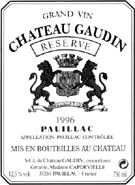
Owner: Linette Capdevielle
Address: 2, route des Châteaux, 33250 Pauillac
Mailing Address: BP 12, 33250 Pauillac
Telephone: 05 56 59 24 39; Telefax: 05 56 59 25 26
Visits: By appointment every day from 10 A.M.–6 P.M.
Contact: Linette Capdevielle
VINEYARDS
Surface area: 24.7 acres
Grape varietals: 85% Cabernet Sauvignon, 10% Merlot, 5% Petit Verdot
Average age of vines: 45 years
Density of plantation: 8,500 vines per hectare
Average yields: 50 hectoliters per hectare
Elevage: Thirty-day fermentation and maceration. Eighteen months aging in concrete vats and two-year-old barrels, with racking every three months. Fining, no filtration.
WINES PRODUCED
Château Gaudin: 75,000 bottles
No second wine is produced.
Plateau of maturity: Within 5–12 years of the vintage
GENERAL APPRECIATION
Worth a Cru Bourgeois Exceptionnel.
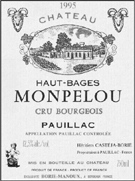
Classification: Cru Bourgeois
Owner: Castéja family
Address: 33250 Pauillac
Mailing Address: c/o Borie Manoux, 86, cours Balguerie Stuttenberg, 33082 Bordeaux Cedex
Telephone: 05 56 00 00 70; Telefax: 05 57 87 48 61
E-mail: domainesboriemanoux@dial.oléane.com
No visits
Surface area: 29.6 acres
Grape varietals: 70% Cabernet Sauvignon, 30% Merlot
Average age of vines: 35 years
Density of plantation: 8,500 vines per hectare
Average yields: 55 hectoliters per hectare
Elevage: Twenty-one day fermentation and maceration in stainless-steel vats. Aging with 20% new oak and 80% one-year-old barrels. Fining, no filtration.
Château Haut-Bages Monpelou: 80,000 bottles
No second wine is produced.
Plateau of maturity: Within 2–8 years of the vintage
GENERAL APPRECIATION
Classification should be maintained.
This vineyard, located inland near that of Grand-Puy-Lacoste, has been owned by the Castéja family since 1947. The wines, light, fruity, and generally undistinguished, are commercialized exclusively by Mr. Castéja’s négociant firm, Borie-Manoux.
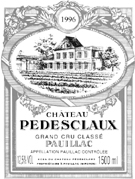
Classification: Fifth Growth in 1855
Owner: GFA du Château Pédesclaux - Jugla family
Address: 33250 Pauillac
Telephone: 05 56 59 22 59; Telefax: 05 56 59 63 19
E-mail: contact@château-pedesclaux.com
Visits: By appointment only, on weekdays (except Wednesdays) 9 A.M.–noon
Contact: Denis Jugla
VINEYARDS
Surface area: 30.9 acres
Grape varietals: 50% Cabernet Sauvignon, 45% Merlot, 5% Cabernet Franc
Average age of vines: 35 years
Density of plantation: 8,333 vines per hectare
Average yields: 48 hectoliters per hectare
Elevage: Eighteen to twenty-two day fermentation and maceration in temperature-controlled stainless-steel tanks. Fifteen months aging in barrels with 60% new oak. Fining, no filtration.
WINES PRODUCED
Château Pédesclaux: 75,000 bottles
Lucien de Pédesclaux: 7,000 bottles
Plateau of maturity: Within 3–10 years of the vintage
GENERAL APPRECIATION
The least-known and probably the most mediocre of all the 1855 classified growths. Should be downgraded to Cru Bourgeois level.
Pédesclaux gets my nod as the most obscure classified growth in the 1855 Classification of the Wines of Gironde. Much of the wine is sold in Europe, particularly Belgium. I have never been impressed, finding it robust but straightforward, lacking depth and, to my taste, having an excess of tannin. In short, life is too short to drink Pédesclaux.
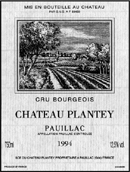
Classification: Cru Bourgeois
Owner: Vignobles Meffre
Address: Artigues, 33250 Pauillac
Mailing Address: c/o Vignobles Meffre, 84810 Aubignan
Telephone: 04 90 62 61 37; Telefax: 04 90 65 03 73
Visits: By appointment Monday to Friday, 8 A.M.–noon and 2–6 P.M.
Contact: Claude Meffre (Telephone: 05 56 59 32 30)
VINEYARDS
Surface area: 64.2 acres
Grape varietals: 50% Cabernet Sauvignon, 45% Merlot, 5% Cabernet Franc
Average age of vines: 28 years
Density of plantation: 6,600 vines per hectare
Average yields: 57 hectoliters per hectare
Elevage: Twenty-one day fermentation and maceration in concrete tanks. Twelve months aging in barrels with 50% new oak. Fining and filtration.
WINES PRODUCED
Château Plantey: 160,000 bottles
Château Artigues: 70,000 bottles
Plateau of maturity: Within 3–8 years of the vintage
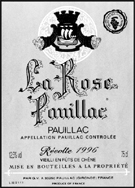
This cooperative, consisting of 125 vineyard owners who control 272 acres of vineyards in Pauillac, was created in 1932. At present, it is the most successful cooperative in Bordeaux, with 6,000 private clients as well as significant sales to many of Bordeaux’s most prestigious négociants. The cooperative produces three cuvées, the majority of which is labeled La Rose Pauillac. In addition, two domains that vinify their wines at the cooperative Château Haut-Milon and Château Haut-St.-Lambert, sell their wines under their own label, but it is entirely made and bottled at the cooperative. The cooperative has been using increasing percentages of small oak barrels, with a tiny percentage of them new. The wines exhibit a soft, agreeable, clean, but not particularly distinguished style. These wines should be drunk in their first 5–7 years of life.
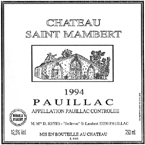
Classification: None
Owner: Domingo Reyes
Address: Bellevue, St.-Lambert, 33250 Pauillac
Telephone: 05 56 59 22 72; Telefax: 05 56 59 22 72
Website: www.château-saint-mambert.fr.st
Visits: By appointment
Contact: Mrs. Reyes
VINEYARDS
Surface area: 1.63 acres
Grape varietals: 65% Cabernet Sauvignon, 25% Cabernet Franc, 10% Merlot
Average age of vines: 45 years
Density of plantation: 10,000 vines per hectare
Average yields: 58 hectoliters per hectare
Elevage: Three week fermentation and maceration in stainless-steel tanks. Eighteen months aging in barrels, with 30% new oak. Fining, no filtration.
WINES PRODUCED
Château Saint Mambert: 4,200 bottles
No second wine is produced.
Plateau of maturity: Within 3–8 years of the vintage
If Pauillac is famous for having the Médoc’s largest number of first growths and Margaux for being the most widely known appellation, St.-Julien is the Médoc’s most underrated commune. The winemaking in St.-Julien—from the lesser-known Cru Bourgeois châteaux such as Gloria, Terrey-Gros-Cailloux, and Lalande-Borie, to the five flagship estates of this commune, Léoville Las Cases, Ducru-Beaucaillou, Léoville Poyferré, Léoville Barton, and Gruaud Larose—is consistently both distinctive and brilliant. The first four of these estates all have riverside vineyards with superb drainage. The last estate, Gruaud Larose, is inland. St.-Julien starts where the commune of Pauillac stops, and this is no better demonstrated than where Léoville Las Cases and Latour meet at the border. Heading south from Pauillac, Léoville Las Cases and Léoville Poyferré straddle both sides of D2 (the Médoc’s Route du Vin), Langoa Barton and Léoville Barton follow on the right, Ducru-Beaucaillou on the left, Branaire Ducru on the right, and Beychevelle on the left. At normal driving speeds, the time necessary to pass all of these illustrious properties is no more than five minutes. Farther inland and lacking a view of the Gironde are the large estates of Gruaud Larose, Talbot, Lagrange, and Saint-Pierre.
While St.-Emilion and the Côtes de Castillon lead Bordeaux’s avant garde winemaking/experimentation revolution and the creation of new micro-estates, there is no commune in the Médoc or, for that matter, in Bordeaux where the art of winemaking is practiced as highly as in St.-Julien. Consequently, the wine consumer has the odds stacked in his or her favor when purchasing a St.-Julien. In addition to a bevy of fine wines from the Cru Bourgeois châteaux of St.-Julien, in particular Gloria, the eleven classified growths are all turning out impeccably crafted wines, yet all vary greatly in style.
Léoville Las Cases is the most Pauillac-like of the St.-Juliens for two main reasons. The vineyards sit next to those of Pauillac’s famous first growth, Latour, and the owner, the late Michel Delon, and his son Jean-Hubert make a prodigiously concentrated and pure, tannic wine marked by the scent of subtle vanilla oakiness allied to majestic levels of cassis and sweet cherry fruit. In most vintages, this wine needs a minimum of a decade to shed its cloak of tannin. With the possible exceptions of Gruaud Larose and Léoville Barton, no other St.-Julien is this stubbornly backward at the outset; most other top properties seem to make wines that do not require as much patience from the consumer.
Léoville Las Cases is one of a trio of St.-Julien estates with the name Léoville. At present, all of them produce superb wines, but Las-Cases is the best of the three, largely because the proprietors, the Delons, have been perfectionists. Of the other two, Léoville Poyferré has immense potential and, fortunately, has begun to exploit it. Like Léoville Las Cases, the office and wine chai sit in the tiny, sleepy town of St.-Julien-Beychevelle. Poyferré’s record was less than brilliant in the 1960s and 1970s, irregular in the 1980s (the 1983 and 1982 were superb), yet highly promising in the 1990s (2000, 1996, and 1990 are triumphant). Today, the wines display much greater strength and richness and a noticeably darker color.
The other Léoville is Léoville Barton. It is an outstanding wine and increasingly consistent, particularly in the vintages that produce lighter, more elegant wines. Since the mid-1980s, the handsome Anthony Barton, one of Bordeaux’s impeccable gentlemen and most charming wine advocates, has been in full command, and consistency has been the rule. Léoville Barton reeks of cedarwood when mature and is a classic, traditionally made St.-Julien that is the most masculine of the St.-Juliens. It is also among the most fairly priced wines in the Médoc.
Anthony Barton also has another St.-Julien property, Langoa Barton. This impressive château sits right on top of the heavily traveled Route du Vin (D2) and houses the winemaking facilities for both Léoville Barton and Langoa Barton. Not surprisingly, Langoa is very similar in style to Léoville Barton—cedary, rich, and flavorful, yet rarely as concentrated as its bigger sister.
The Italianate mansion dominates the St.-Julien estate of Ducru-Beaucaillou. This estate can challenge Léoville Las Cases and the Médoc first growths in quality each year. I vividly remember my first visit to Ducru-Beaucaillou in 1970 when I asked the old cellar master, M. Prévost, what the secret to Ducru’s remarkable consistency was. He simply stated, “Selection, selection, selection.” This is an expertly run property where the owners, the genteel Borie family, oversee every step of the winemaking procedure. The château has a gorgeous location overlooking the Gironde, and the style of wine made here, while less massive and tannic than Léoville Las Cases or Léoville Barton and less overtly powerful and heady than Gruaud Larose, is a classic St.-Julien that needs 8–10 years to reveal the rich, fruity, elegant, suave flavors. If Léoville Las Cases is the Latour of St.-Julien, Ducru-Beaucaillou is St.-Julien’s Lafite Rothschild. The estate went through an unexpected slump in the late 1980s, but quickly regained form, producing spectacular wines in 2000, 1996, and 1995.
Within shouting distance of Ducru-Beaucaillou are Branaire Ducru and Beychevelle, the two most southern St.-Juliens. Beychevelle is widely known, perhaps because tourists love the gardens (among the Médoc’s most photogenic), and the wine is supple, fruity, light, and quick to mature. While good, even outstanding as in 1989, 1986, and 1982, Beychevelle has always had a better reputation than its performance record would lead one to believe. Call it Château Inconsistency on my scoring sheet.
Just the opposite is the case with Branaire, the rather drab, sullen-looking château across the road from Beychevelle. Despite a slump in quality after 1982, Branaire rebounded strongly with a fine effort in 1989, followed by very good offerings in 1995 and 1994 and exceptional wines in 1996 as well as 2000. Furthermore, the price for Branaire remains one of the lowest for a wine of such quality. Branaire is a slightly bigger wine than its neighbor, Beychevelle, but it clearly emerges from the school of winemaking that favors finesse over massive power and extract. It possesses an unmistakable exotic, richly scented bouquet of cedar and chocolate in addition to blueberry/raspberry fruit flavors and a liquid minerality. A singular style of wine, Branaire will never have the aging potential of the three Léovilles or Ducru-Beaucaillou, but between the ages of 8 and 20, Branaire can be an opulently rich, distinctive style of wine.